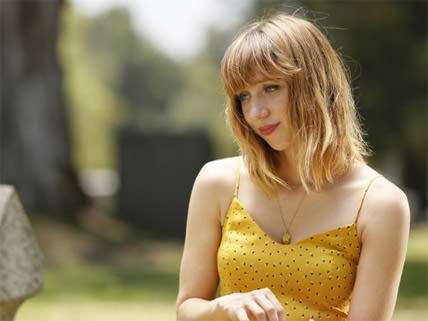The Pretty One
Zoe Kazan shines again in a case of mistaken identity.

Laurel and Audrey are identical twins, but they couldn't be less alike. Laurel is mousy and muddled; in her early twenties, she's still living at home with her widowed father, going nowhere. Audrey – the pretty one – has moved out into the world; she has a cool job, a boyfriend – everything Laurel wishes she could have, but suspects she never will. Out driving around during a brief reunion, the girls collide with a truck. Audrey is killed, and Laurel comes to not knowing at first who she is. Her grieving dad thinks she's Audrey – that it was Laurel who was killed. Laurel soon realizes that's not the case. But she has always envied her sister's life; now, if she wants, she can have it.
The Pretty One is a first feature by writer-director Jenée LaMarque. The movie is a lot of fun in parts, but it's subverted by lazy plotting and narrative tones that clash like soup-pot cymbals. Fortunately, it also has Zoe Kazan, playing both Laurel and Audrey. And as anyone who saw her at full glow in Ruby Sparks might guess, Kazan is enough to make the movie worth seeing.
Having one actor play a pair of twins is basically a stunt, and LaMarque brings it off with seamless digital ministrations. The real wonder, though, is the way Kazan manages to create two separate characters almost entirely through gesture and bearing and carefully calibrated details of personality. (The scene in which we see Laurel and Audrey laughing and bantering in the front seat of a pickup is a small triumph of artistic concentration.)
We meet Laurel first. She's pathetic, drifting around her childhood country home in her dead mother's dresses while tending to her mopey dad (John Carroll Lynch), an entirely implausible character who occupies himself painting copies of famous masterworks (the Mona Lisa, and so forth). "You're like his wife," says Audrey, popping in for a birthday visit. Audrey has brought some strained foreshadowing with her. She treats Laurel to a salon makeover (she opts for a haircut just like Audrey's, naturally), and is about to take Laurel with her back to the big city (Los Angeles, apparently) when the fatal crash occurs. It is entirely unbelievable that everyone should decide that the living Laurel must be the dead Audrey, but they do. Attending her own funeral, Laurel is crushed to realize that no one has a fond word to say about her. So she takes the plunge, packs up and moves to LA.
Nobody at the real-estate agency where Audrey worked registers any doubts when Laurel turns up to take her place. She's pretty bad at showing houses to prospective buyers, but she quickly gets better, as we know she must. She also gets to meet Audrey's boyfriend, Charles (Ron Livingston), a beardy smarm-bag who is also—Audrey never mentioned this—married. This situation might have been fine with Audrey. But Laurel—as even Charles inexplicably fails to realize—is not Audrey.
The movie comes most alive after Laurel moves into her sister's apartment and makes the acquaintance of her next-door neighbor, Basel, who's played—with radiant, low-key charm—by Jake Johnson, of New Girl. The ambitious Audrey had no time for Basel—she called him a "creepy man-child," and we can understand how his aimless amiability might have rubbed her the wrong way. But he's just right for Laurel—and Kazan and Johnson vibrate on the same sweet wavelength as their characters are drawn together toward the happy ending that's inscribed in the story's DNA.
The movie has a considerable amount of heart, however overplayed, and it's shiny and clever and, Lord knows, lovable. If only it had been more tightly conceived. Launching a whimsical tale like this with a violent death feels off, and Laurel's stay-at-home relationship with her strange dad is borderline creepy. The byplay with married boyfriend Charles exists to serve a single plot point, and another story element—a support group for "Twins without Twins"—goes limp the moment it appears. But Kazan, with her googly eyes and carefully shaded reactions, can sell us on almost anything—even the plausibility of reacting to a life crisis with a cry of, "We need to get some ice cream!" She makes you want to believe.



Show Comments (5)